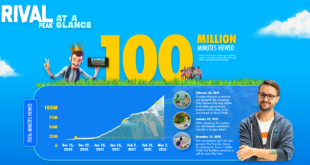A classic game category that has been played by diverse audiences over the years, arcade games such as Bejeweled Blitz, Fruit Ninja Frenzy, and Diamond Dash have been picking up momentum on Facebook Platform lately. Whether on mobile or desktop, these short-session games use a variety of tactics to keep people coming back week after week and to encourage friendly competition.
Arcade games growing on Facebook
In our research, people who play arcade games do so because the games are quick and easy to play and are a fun way to compete and socialize with friends. In fact, arcade games are among the most highly rated games on Facebook.
As a result, these games have seen steady growth in active users month after month. For example, two of the most played arcade games on Facebook, Diamond Dash and Bubble Witch Saga, have seen nearly 10% growth or more in daily active users in the last five months, with Bubble Witch recently crossing the 5 million daily active users milestone and Diamond Dash not far behind.
Let’s take a look at some of the techniques that arcade games use to achieve steady growth and high engagement on Facebook.
Bringing friends into the game
Healthy competition among friends is a great way to motivate action. Zuma Blitz and Bubble Island show a person’s friends in the game either with an in-game leader board or a story map that shows other friends’ progress. People are motivated to play more to catch up to their friends’ scores or level advancement. Including an "invite" button on or close to the leader board, as Zuma Blitz does, reminds people to invite more of their friends to compete.
Zuma Blitz (top) uses the classic leader board; whereas Bubble Island’s (bottom) is part of a story map.
The Graph API for scores fuels this competitive spirit by capturing and distributing high score stories in news feed. Both players and non-players will see these stories, driving current players to play again and encouraging new players to jump in on the action. For example, Candy Dash has implemented scores and publishes stories like the one below when a person reaches a new high sore.
Bragging
Leader boards are even more impactful when they offer people a way to brag about their accomplishments. For example, if a person passes one of her friends, Bubble Witch Saga uses the feed dialogue to prompt the player to brag. This post then appears on the friend’s timeline.
Bubble Witch Saga prompts the person to share when she passes a friend (left) and the message appears on that friend’s timeline (right).
Weekly Tournaments
Many arcade games, such as Bejeweled Blitz and Diamond Dash, use weekly tournaments to keep people coming back each week. This lightweight competition is compelling and draws players back to the game to beat their friends.
We recently announced that instead of publishing high score and passing stories based on a person’s all-time high score, our Graph API for scores will publish these stories based on a player’s current score. Now games with recurring tournaments can reset players’ scores with each new tournament to generate new high score and passing stories, gaining more distribution for their game on Facebook.
Tournaments are another way to help people discover new games through Open Graph and a person’s timeline by publishing stories about the weekly winners. For example, Diamond Dash publishes a story for each medal that a player wins in their weekly tournaments.
Beating friends in a weekly tournament isn’t always about being the most skilled player. Oftentimes, arcade games monetize by selling power-ups, such as a score multiplier or boosts. For example, in Fruit Ninja Frenzy, players can purchase new boosts to enhance their performance instead of waiting to unlock them in future rounds of game play.
Collaborative competition and gifting
Arcade games typically use a scarce resource–such as energy or life–to gate game play. Players can either buy resources or ask their friends via requests. This creates a highly social environment where friends compete against each other, but also rely on each other’s gifts of more “lives” to keep playing. Gifting is highly social in nature; gifting a life inspires a gift in return, which fuels the cycle of giving and prompts interaction and engagement among friends.
Make gifting lives even easier to do by using frictionless requests, which eliminates the request dialog pop-up after a user has checked the "do not ask again" box.
Another way to make the gifting cycle simple is to provide visual reminders and easy ways to begin giving. For example, games like Collapse Blast show a “life” icon next to players’ pictures on the leader board, an easy-access reminder to gift.
Overall, arcade games are a strong example of how to make a simple casual game social and drive growth and engagement from the Facebook audience. By integrating with Facebook’s social channels to drive more interaction with their leader boards, weekly tournaments, and gifting, these games keep players highly engaged and coming back week after week to beat their friends.

 MCV/DEVELOP News, events, research and jobs from the games industry
MCV/DEVELOP News, events, research and jobs from the games industry



